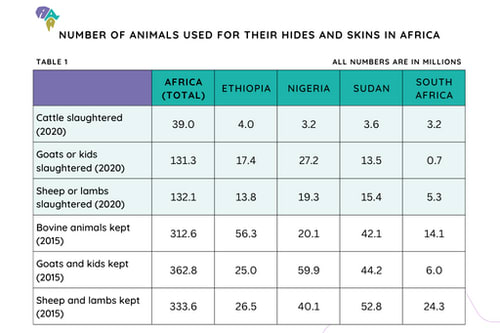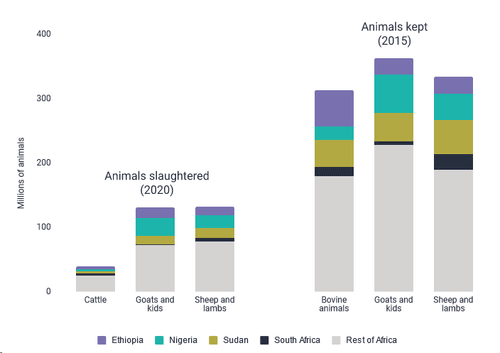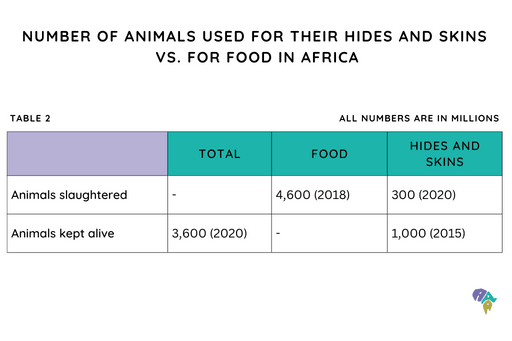Context and disclaimers
- We originally published this research as a blog post on our website in January 2023. That post also included a guest contribution by FOUR PAWS South Africa. We decided to post our own part of this research on the EA Forum now in order to make our research better accessible to the wider EA audience.
- This was only a shallow investigation to roughly understand the scale of animal farming for non-food purposes in Africa. Much deeper research would be needed to properly evaluate the promisingness of interventions in this area.
Executive Summary
The suffering caused to animals used for their hides and skins (such as in the fashion or leather industry) might be an underexplored area within the Effective Animal Advocacy community, as focus is usually put on the use of animals for food production. To understand more about this issue and refine our organisation's strategic prioritisation, we did a shallow analysis and ran the numbers, limiting our analysis to Africa as the geographic focus of our organisation. We find that work to help animals farmed for their skins and hides can be worthwhile compared to other animal groups such as companion or working animals, but also conclude that animals farmed for food production should remain our top priority.
What do we know about animals being farmed outside the food system in Africa?
Number of animals kept and slaughtered for their hides and skins
The Food and Agriculture Organization of the United Nations (FAO) publishes comprehensive data on the number of animals slaughtered for their hides and skins (including wool, leather, etc.) across the world. According to their database FAOSTAT, roughly 300 million animals were killed for their hides and skins in Africa in 2020. The majority were goats and sheep (~260 million) and the leading countries were Nigeria (~50 million), Ethiopia (~35 million), and Sudan (~33 million). South Africa, the focus country for FOUR PAWS' blog post on our website, was in eighth place, slaughtering ~9 million animals for their hides and skins in 2020. Table 1 below provides an overview and detailed figures can be found in the spreadsheet we set up for this research.
In 2016, the FAO also published a report on raw hides and skins, leather and leather products, showing that roughly 1 billion animals were kept for use of their hides and skins in Africa in 2015. Across Africa, these numbers had steadily increased since 2005. Similar to the slaughter statistics, leading countries in animals kept are Sudan (~139 million animals), Nigeria (~120 million), and Ethiopia (~108 million). In South Africa, ~44 million bovine animals, goats, and sheep were kept for use of their hides and skins in 2015. Detailed numbers for 2015 are also shown in Table 1. For better visualisation, we also include a graph illustrating these figures.
While we did not do an in-depth analysis of this data, it seems that the number of animals farmed for their hides and skins is increasing in developing countries, while it is stagnating or even decreasing in developed countries - a pattern that seems similar to food production (see below for the interrelatedness of these two farming purposes).
The FAO report also shows that the number of animals kept alive is even higher than the number of animals slaughtered per year, which is likely due to the fact that the animals analysed here typically have a longer life-cycle compared to other, smaller farmed animals like chicken.
Please note that the FAO numbers cited only include sheep, goats, and bovine animals like cattle and buffaloes. It does not cover other animals that are also farmed for their hides and skins, like ostriches and crocodiles. However, the numbers given by the FAO should cover the most widely used animals and should thus give a good estimate of the magnitude of the issue.
Comparison to the scale of other animal issues
Compared to other animal issues, the scope of this problem appears large. For reference, in our prioritisation report, we estimated the number of live companion and stray animals in Africa to be in the low hundred million and the number of working animals to be somewhere around 35 million.
These numbers also show that the use of animals for their hides and skins makes up a significant proportion of farmed animals in Africa. In 2020, there were ~3.6 billion live land farmed animals in Africa, including both animals raised for food as well as for their hides and skins (and potentially other purposes). Based on this number and the above estimate of ~1 billion animals kept for their hides and skins in 2015, we can estimate that roughly one quarter of all animals farmed in Africa are farmed for their hides and skins.
The number of farmed land animals slaughtered for food in Africa in 2018 was at ~4.6 billion, substantially higher than the above-indicated 300 million animals slaughtered for their hides and skins in 2020, suggesting that food production is the major contributing factor for animal slaughter in Africa. The higher number of slaughtered animals compared to live animals in food production is mostly a result of the large number of chickens, who have a much shorter lifespan than most of the other land animals in scope.
It is important to highlight that many animals can be used for multiple purposes. A dairy cow could be used for milk production during her lifetime, while her skin is used for leather production after she has been slaughtered, or a sheep can be used for both wool and cheese production. We did not spend a lot of effort on evaluating these different uses and potentially disentangling the impact that each of them has on animal suffering, as this would require a much larger research effort.
However, a strong argument can be made that hides and skins are increasingly becoming a non-valuable byproduct of meat and dairy production. While hides and skins have historically been a valuable part of an animal, the situation is shifting, as demand for meat and dairy products has increased and is still growing, while demand for leather products is on a downward trajectory on a global level. With skins and hides from the meat and dairy industries in abundant supply, the commercial case for raising and killing animals for their hides and skins can become very weak in many industries.
Despite this primacy of food production as a factor in driving animal farming, there are animal groups, like ostriches, that are farmed primarily for their hides and skins. In general, the balance of food vs. hides and skins as the most important economic factor for farming probably varies substantially between animal groups. While for most animals (e.g, chicken and cows), the majority of their economic value should lie in food production, the picture is less clear for others (e.g., sheep or goats), and some animals (e.g., ostriches) are even farmed primarily for their hides and skins.
Conclusion
This leads us to the conclusion that an emphasis on animals farmed for food production is warranted, if we want to have the largest positive impact on the lives of animals. However, as the production of skins and hides is interrelated with food production and involves the farming of roughly one billion animals across Africa, we do not want to categorically exclude this topic from our work and wider discussions on farmed animal welfare in Africa - especially when considering industries or animal groups where hides and skins are the main driving factor for intensive farming. We assume that projects to help animals farmed for their skins and hides can be worthwhile compared to other animal groups such as companion or working animals, while animals farmed for food production should remain our top priority.




Nice overview of the issue @Moritz Stumpe! It is good to see that the demand for animal skin products has been decreasing so clearly. I wonder if this lower demand has any potential tangible impact on the profitability of the animals that are farmed predominantly for their meat, with their skins being sold as a secondary product.
Thank you Zuzana!
If you haven't yet, I can recommend this article that I linked in the post which gave me some food for thought on the interplay between farming for meat and leather.
Please also note that the statement "demand for leather products is on a downward trajectory on a global level" is based on that article and I didn't dive deeper into this, since this was only a shallow review. Would have to do more detailed research to be very confident in this.